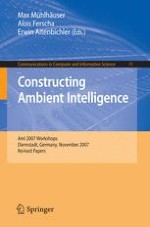A foreword for the present workshop proceedings cannot be provided without first looking at the larger context of the AMI conference in which the workshops were organized. The AMI 2007 conference has roots in preceding events, but in many respects, AMI can be called a novel conference format and hence a premiere. Among the several aims that inspired and shaped this new conference format, the following two are particularly worth considering: (1) to provide a forum for the ambient intel- gence flavor of research on the Post-PC era of computer science, complementing the ubiquitous computing and pervasive computing flavors emphasized by alrea- existing conferences; (2) to offer an event that attracts contributions from all over the globe yet emphasizes European strengths – with particular reference to the Infor- tion Society Technologies (IST) branch of the EU research framework programs (FPs), which carry the same label as the conference. The workshop organization chairs reflected these unique characteristics of the new AMI conference series in the call for workshop proposals using two corresponding measures: (1) by particularly soliciting workshops on in-depth topics corresponding to the above-mentioned ambient intelligence flavor of Post-PC research; (2) by offering two different workshop threads: one ‘usual’ thread for advanced topics (called “SW workshops”) and one thread for workshops related to concrete EU FP6 and FP7 p- jects (called “EU workshops”).
